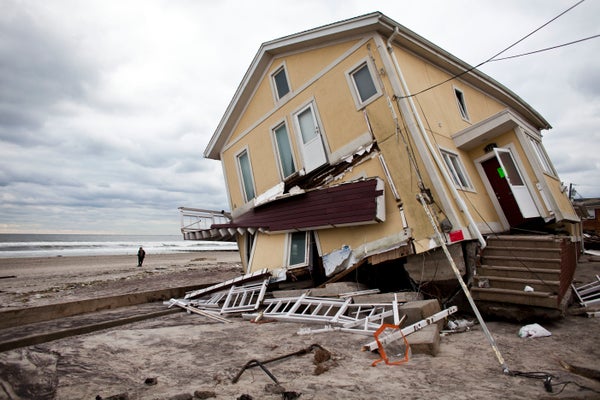[ad_1]
January 5, 2024
3 minimum reading
The purchase and demolition of homes damaged by Hurricane Sandy boosted business development, jobs, and property values in nearby neighborhoods.

A beachfront home and a car are damaged after Hurricane Sandy in the Belle Harbor section of Queens, New York, on November 1, 2012.
CLIMATE CABLE | Local property values and business development rose after a large government program was used to buy flood-damaged homes in the wake of one of the country’s most expensive hurricanes.
Findings from researchers who studied a home purchase program in New York offer economic support for the practice of purchasing damaged homes and then demolishing or redeveloping them to avoid using public funds to repeatedly repair homes in high-risk flood areas. . The report comes as scientists say climate change is intensifying rainfall and other causes of flooding.
Researchers from Resources for the Future, an economic think tank focused on environmental policy, took the unusual step of analyzing local property values and business development following the purchase of 1,300 homes by the NY Rising Purchase and Acquisition Program after Hurricane Sandy devastated parts of the East. Costa in 2012. The program generated almost 5 billion dollars in benefits through higher property values, job creation and greater resilience, the researchers found.
Most studies on home purchase programs have evaluated how much flood damage was prevented by demolishing homes and leaving lots empty.
“This type of program is an effective disaster recovery program,” said Penny Liao, co-author and economist at Resources for the Future. “Many times local communities distrust these programs. But overall we find that these programs create positive economic impacts.”
The acquisitions resulted in economic benefits that were nearly eight times greater than the program’s $640 million cost, researchers estimated.
The report, described as a working paper, stopped short of saying the program resulted in “gentrification” (when wealthier people move into a neighborhood and displace long-time residents) because property ownership rates Housing shortages are high in affected areas and few tenants were displaced. The program primarily focused on homes in Staten Island and Long Island.
“The economic changes we see are consistent with neighborhoods experiencing gentrification,” Liao said, before adding, “The positive impact is likely predominant because most homes in these neighborhoods are owner-occupied.”
The New York program was unusual because about half of the 1,300 properties were converted to open space and the other half were sold for redevelopment. Most buyout programs involve only the creation of open space, as they prioritize the elimination of flood damage.
New York paid for the program primarily with the $4.5 billion in disaster aid the state received from the U.S. Department of Housing and Urban Development after Sandy, which NOAA ranks as the fifth costliest disaster in U.S. history. , with 87 billion dollars in damages.
The researchers analyzed the neighborhoods immediately around the 1,300 properties (many of which were clustered) and found that property values and commercial development increased by a greater margin than in nearby areas.
The report says that a single state purchase “significantly increases property values” within a 1 kilometer radius. The acquisitions also had “positive impacts on nearby commercial establishments and urban services.”
The researchers found that properties the state bought and sold to a developer generally produced greater profits than properties the state converted to open space.
New York focused on purchasing heavily damaged homes in devastated areas. The communities are mostly middle- or upper-middle-income parts of Staten Island and Nassau and Suffolk counties and exclude wealthy areas on the North Shore and the eastern tip of Long Island, which were not severely damaged.
The report expands on previous research on buyout programs and the effect of Sandy in the New York City area.
Previous studies have shown that the storm decreased property values across the region, in part because it raised awareness about flood risk. Those studies did not analyze New York’s procurement program.
Other studies have shown that buyouts are effective in reducing flood damage, but create community concerns by creating conspicuous vacant lots and lost property tax revenue.
Reprinted from E&E News with permission from POLITICO, LLC. Copyright 2022. E&E News provides essential news for energy and environmental professionals.